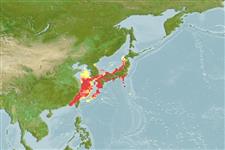Пластиножаберные (акулы и скаты) (sharks and rays) >
Heterodontiformes (Bullhead and horn sharks) >
Heterodontidae (Bullhead, horn, or Port Jackson sharks)
Etymology: Heterodontus: heteros (Gr.), different; odontos (Gr.), tooth, referring to pointy teeth (for clutching prey) at front of jaws, different than rounded molar-like teeth (for grinding hard-shelled invertebrates) at the back (See ETYFish); japonicus: -icus, (Gr.) belonging to: Japan, described from a collection of fishes from the seas of Japan (See ETYFish).
More on authors: Miklouho-Maclay & Macleay.
Environment: milieu / climate zone / depth range / distribution range
экология
морской демерсальный; пределы глубины 6 - 100 m (Ref. 106604). Subtropical; 43°N - 23°N, 118°E - 143°E
Northwest Pacific: off Japan, Korean Republic, northern China including Taiwan Island.
Size / Вес / Возраст
Maturity: Lm ? range ? - ? cm
Max length : 120 cm TL самец/пол неопределен; (Ref. 247)
Found near shore on the continental shelf, more commonly on rocky and kelp-covered bottom (Ref. 43278, 11230). Feeds on crustaceans, mollusks (including top shells), small fishes and sea urchins. Oviparous (Ref. 43278, 50449). Grabs prey by protruding its jaw with considerable distance.
Life cycle and mating behavior
половая зрелость | размножение | нерест | икра | Fecundity | личинки
Oviparous. Eggs are laid in rocks or in kelp at depths of about 8 or 9 m and are present from March through September. Eggs are more abundant, however, in March and April. Eggs are hatched in about a year; size at hatching is about 18 cm. There may be a `nest' for several females laying eggs but this is not a true nest. A female lays two eggs at a time, for 6 to 12 spawnings.
Compagno, L.J.V., 1984. FAO Species Catalogue. Vol. 4. Sharks of the world. An annotated and illustrated catalogue of shark species known to date. Part 1 - Hexanchiformes to Lamniformes. FAO Fish. Synop. 125(4/1):1-249. Rome, FAO. (Ref. 247)
Статус Красного Списка МСОП (Ref. 130435: Version 2024-2)
Угроза для людей
Traumatogenic
Использование человеком
рыболовство: не имеет хозяйственного значения
дополнительная информация
инструменты
Специальные отчеты
Скачать в формате XML
ресурсы в Интернет
Estimates based on models
Preferred temperature (Ref.
123201): 16.6 - 23.5, mean 20.5 °C (based on 50 cells).
Phylogenetic diversity index (Ref.
82804): PD
50 = 0.5059 [Uniqueness, from 0.5 = low to 2.0 = high].
Bayesian length-weight: a=0.00380 (0.00165 - 0.00876), b=3.15 (2.95 - 3.35), in cm total length, based on LWR estimates for this (Sub)family-body shape (Ref.
93245).
Trophic level (Ref.
69278): 3.6 ±0.53 se; based on food items.
устойчивость к внешним воздействиям (Ref.
120179): низкий, минимальное время удвоения популяции 4.5-14 лет (Fec=12).
Fishing Vulnerability (Ref.
59153): High to very high vulnerability (72 of 100).
